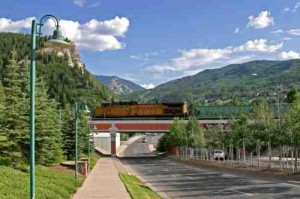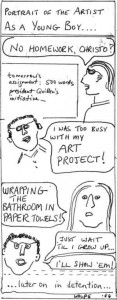Column by John Mattingly
Agriculture – October 2006 – Colorado Central Magazine
WALK INTO ANY FOOD STORE in the United States — be it a species of super box store, a supermarket, or a gas-n-go shop on the highway — and you have to be impressed with the magnitude of selections. The old mom-and-pop grocers I recall from the ’50s and ’60s had one kind of cracker (Saltines) three kinds of bread (Wonder, White, and Wheat), perhaps half a dozen kinds of soda pop, and one corner devoted to produce, another to meat, the butcher wielding his cleaver on demand.
Today’s food store offers at least 38 kinds of crackers, 48 bread types, too many soda varieties even to count, and vast produce and meat sections. Every item offered throughout the store has multiple kinds, types, or classes to chose from. Even salt. Our local supermarket offers six kinds of salt, including Kosher. At first glance, this is a success story of abundance and diversity, something even a radical tree-hugging granola cruncher might curtsy to as a triumph.
Yet, there’s something eerie about this particular diversity. For one thing, mom isn’t sitting behind the cash register protecting the jars of penny candy with a kindly smile; the butchers work in secret; and pop isn’t dusting the shelves with ostrich feathers.
In fact, there doesn’t appear to be much dust to whisk. Expanses of linoleum under a fluorescent canopy make the modern food store nearly as impersonal and hygienic as a hospital operating room, and at the same time make one feel like a hunter-gatherer, reading content labels to see if the item will kill sooner, or later.
And everything is presented anonymously: every carrot stick, box of cereal, cut of meat, loaf of bread, down to the last item in the store seems to come from nowhere. There is no connection between the item on the shelf, where it came from, and the foraging consumer stalking the aisles.
There might be a picture of Paul Newman, Ben and Jerry, or Juan Valdez on a package, but these don’t really give you much of an association with the herb fields at the source of Newman’s dressing, the milk barns necessary for Ben and Jerry’s ice cream, or the plantation where Juan Valdez harvested his beans.
No other species gathers food in the way and manner of Homo sapiens sapiens. Other species look their meal in the eye, see it at its origin, know what they’re getting (except those species who dine under the auspices of sapiens sapiens, such as hamsters, dogs, and feedlot cattle who’ve been forcibly conformed to aberrant eating habits.)
Though I’m not certain why humans have willfully chosen to deliver our food supply in a dissociative, sterile, and anonymous state, a series of suspicions follow.
1. The growing of food involves direct contact with nasty (natural) elements: bugs, snakes, dust, weeds, lightning, manure, dead animals, heat, cold, wind, to mention a few. The harvesting of food is either stoop labor or boring, done mostly by migrants or machines. The processing of food is done largely in the industrial wastelands on the outskirts of urban areas and is ugly. For the consumer to witness all this would have a distinctly negative impact on appetite.
The old joke about sausage (“you don’t want to be there when it’s being made”) is remarkably relevant to most food items, because once you leave a store’s produce section (and its thespian thunderstorms), you are, for the most part, looking at row upon row of complex industrial sausages. Examine the label on almost any item on any shelf and try to digest the significance of all the ingredients. Most of us don’t, not wanting to know what they really are.
2. Relatively inexpensive fossil fuels have enabled the transport of food products over large distances, making it impossible for the grower of, say, Peruvian champagne grapes, to stand next to the store display and shake hands with passing gatherers.
3. Finally, and perhaps at the root of it all is this: Food is relatively cheap in the United States, when expressed as a percentage of annual income. Most of the world’s folks spend between 30 and 80% of their annual income on food. In the U.S. we’re getting obese, spending a mere 12% of our annual income on food. (Car and house payments take close to 60%.) The reason we’re getting fat while spending so little is that in the U.S., calories are cheap.
THE REASON CALORIES are cheap is that calorie-rich corn and soybeans are cheap. These two crops are the dominant duo of U.S. agriculture and are in fully two-thirds of the items in the modern food store, either as themselves, or disguised as starch, oil, sweetener, a plethora of additives and stabilizers, and even packaging.
Check labels: trace the origin of the ingredients, and most will lead to either corn or soybeans. Beef, chicken, pork, eggs, dairy, and lately, salmon don’t have corn and soybeans on their package, but carry hefty bundles of both.
The reasons behind the cheapness of corn and soybeans is complex and would make a filling subject for an entire essay, but for now, suffice it to say it is a simple truism that these two crops are cheap. With a couple of notable (and memorable to farmers) blips in the market, the price of corn and soybeans has remained nearly the same for over 40 years.
Any person in the U.S. can go to a farm that grows corn and soybeans (most farmers grow these two in rotation, though west of the Colorado-Kansas line it will be corn and pinto beans) and that person can purchase from the farmer enough corn and beans for a family of four for an entire year for $100.
That’s right: at the farm, $100 will fetch about 1000 pounds of corn and about 500 pounds of beans. Another $100 will purchase enough apples, peaches, and cherries for a family of four for an entire year.
Apart from the fact that we’ve become accustomed to eating bananas and blueberries in January and any vegetable any day of the year, the problem with this strategy of food distribution is that most people wouldn’t have the foggiest idea what to do with all that corn and beans.
They wouldn’t know how to make them into meal, bread, oil, or milk, and they certainly wouldn’t know how to transform them into pop tarts, xantham gum, soda pop, tofu, whiskey, or chicken nuggets. Besides, having people get their food direct from the grower, facing him in the eye and talking about the life cycle of what they are about to eat, is no way to run an industrial food system.
IN THE MODERN industrial food system, the farmer dumps annual surpluses of corn and beans at the elevator, dusts off his overalls while accepting a check from Cargill or ADM, and then (or later) a smaller check from Uncle Sam, and the farmer’s work is done, his responsibilities extinguished.
He not only doesn’t care what happens to his kernels of corn and beans, their identity is lost in the stream of similar commodities now flowing into the industrial system where it eventually becomes a product on the shelf, after being manipulated by food scientists, who we have decided, perhaps by default, know more about what we should eat than we do.
The sterility and anonymity of the modern food store reflect our willingness to delegate to science and industry all the chores of growing, harvesting, and processing food: from the field (where there are noisome natural irritations, not to mention chemicals the farmer used, some of which might have drifted out of label compliance while no one was looking) through to the toil and/or tediousness of the harvest (where used oil, candy wrappers, and mice might find their way into the mix), and finally to the processing facility, where the sausage of industrial food products are stuffed into neat, nifty, and attractive packages.
For this food industry to grow at a rate acceptable to Wall Street, so must we grow, and by the looks of waistlines, many of us are doing our part.
John Mattingly is a recovering farmer who lives near Moffat.


